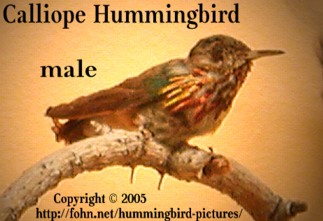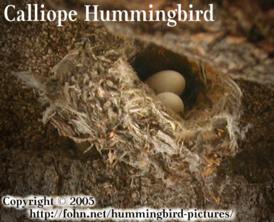|
Calliope Hummingbird
Scientific name: Stellula calliope
Length: 2 3/4 - 3 1/4 inches (7 - 8 cm)
Identification: The distinctive purple-violet streaks on the calliope hummingbird's
white gorget (throat) distinguishes it from all other North American hummingbirds,
which have solid-colored gorgets. Males are metallic green above with a whitish breast.
Females are green above and white below, having white-tipped corners of tail feathers,
dark streaks on the throat, and buffy (light yellow-brown) flanks.
Habitat and range: The calliope hummingbird is found in the mountain meadows
of northwestern America and southern coastal British Columbia.
FYI: The calliope hummer is the smallest bird in North America at about 3
inches long. Since they inhabit the colder mountainous regions of western North America,
they become torpid -- a type of hibernation or "noctivation" -- by lowering
their body temperature at night, reducing their heartbeat, and bringing down their
respiration -- to conserve energy. Source: "Calliope Hummingbird," Book
of North American Birds, (Pleasantville, New York: Reader's Digest Association, Inc.,
1990), p. 196. The tiniest hummingbird is the bee hummingbird of Cuba at 2 inches
(5 cm) long -- which is an endangered species -- while the largest is the giant hummingbird
of the Andes Mountains of South America at 8.25 inches (21 cm) long. Source: Donald
F. Bruning, "Hummingbird," World Book Encyclopedia, 2005, Vol. 9, pp. 433-434.
The word "calliope" comes from the Greek kalliope, meaning "beautiful
voice." A calliope is a keyboard musical instrument, often played in circus
parades and on riverboats, producing sound by sending steam through whistles. Joshua
C. Stoddard of Worcester, Massachusetts invented the calliope in 1855. Evidently,
the one who christened this hummer the "calliope" thought that it had a
"beautiful voice." Of course, this has nothing to do with the voice of
a calliope hummingbird, but, click on the link, if you would like to hear a calliope
play the "Stars
and Stripes Forever" -- courtesy of Mechanical Music Digest's Calliope Home Page!
Outside links:
|
Pictures: click picture(s) for larger version, photo credits, and description.


|

![]()
![]()

![]()
![]()